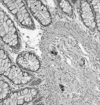The loss of calretinin expression indicates aganglionosis in Hirschsprung's disease
- PMID: 15220363
- PMCID: PMC1770342
- DOI: 10.1136/jcp.2004.016030
The loss of calretinin expression indicates aganglionosis in Hirschsprung's disease
Abstract
Background: Hirschsprung's disease (HD) is a congenital disorder characterised by the absence of ganglion cells in the large bowel, leading to functional obstruction and colonic dilatation proximal to the affected segment. A subclass of nerve cell bodies in both submucosa and myenteric ganglia of the human gastrointestinal tract were found to show immunopositivity for calretinin, a calcium binding protein, which plays an important role in the organisation and functioning of the central nervous system.
Aim: To investigate calretinin immunostaining in ganglionic and aganglionic HD colon specimens, and compare it with staining for S100, neurone specific enolase, and c-kit.
Methods: Ten large bowel, full thickness specimens from patients with classic rectosigmoid HD were selected from the pathology repository. In total, 54 paraffin wax blocks-24 from the ganglionic zone, 17 from the aganglionic zone, and 13 from the transitional zone-were processed.
Results: Calretinin was not expressed in aganglionic segments of HD and associated nerve fibres, whereas in ganglionic HD segments and in normal colon both ganglion cells and nerve fibres were immunopositive. In addition, c-kit showed an altered distribution in the interstitial cells of Cajal. The transitional zone showed a broad spectrum of histomorphological and immunohistochemical patterns of both calretinin and c-kit expression.
Conclusion: The absence of calretinin expression may serve as a diagnostic aid in identifying aganglionic segments in HD.
Figures



References
-
- Bodian M , Stephens FD, Ward BCH. Hirschsprung’s disease and idiopathic megacolon. Lancet 1949;1:6–11. - PubMed
-
- Larsson LT. Hirshprung’s disease—immunohistochemical findings. Histol Histopathol 1994;9:615–29. - PubMed
-
- Qualman SJ, Murray R. Aganglionosis and related disorders. Hum Pathol 1994;25:1141–9. - PubMed
-
- Yunis EJ, Dobbins EW, Sherman FE. Rectal suction biopsy in the diagnosis of Hirschsprung’s disease in infants. Arch Pathol Lab Med 1976;100:329. - PubMed
-
- Maia DM. The reliability of frozen-section diagnosis in the pathologic evaluation of Hirschsprung’s disease. Am J Surg Pathol 2000;24:1675–7. - PubMed
MeSH terms
Substances
LinkOut - more resources
Full Text Sources
